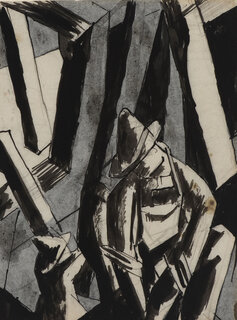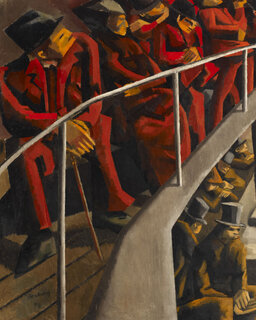
© Marc Chagall estate
Apocalypse en Lilas, Capriccio was unveiled at a special exhibition to mark its acquisition, at Osborne Samuel in Mayfair in 2010, with a new text by Chagall expert Professor Ziva Amishai-Maisels. Chagall's work was first exhibited at Ben Uri in 1934 and has since been shown on numerous occasions including Chagall and his Circle (2006) and From Russia to Paris: Chaïm Soutine and his Contemporaries in 2012, reconfigured as Soutine, Chagall and the School of Paris at Manchester Jewish Museum in 2013 simultaneous to the major Chagall show at Tate Liverpool. Most recently, it was loaned to the important Chagall retrospective in New York (2013), Milan (2014) and Brussels (2015). This important gouache, ink and pencil study was most likely executed in April 1945 when Chagall was in exile in New York due to the Nazi occupation. It was probably the first work he produced after coming out of mourning for his late wife, Bella (who had died suddenly in September 1944), and was created in direct response to seeing the horrors of the concentration camps revealed through newspapers and Pathé newsreels. Previously, Chagall's crucifixions had symbolised the Nazi's Jewish victims in order to remind Christians that Christ was a Jew and they should stop persecuting his brothers. However, here Chagall incorporates factual information about the Holocaust for the first time. The clock in the top right of the study is missing its minute and hour hands, casting this moment in history as the end of time - the apocalypse. Below, a series of complex and horrific scenes uncover the extent of Jewish suffering during the Holocaust, among them another crucifixion, a hanging and a boatload of refugees.

